The Record Store Years (Side Trip) Led Zeppelin in Seattle March 1975 Pt. 1
A memoir of 25 years (1975-2000) spent working in the world of records & music in Seattle, with occasional side trips into writings on Led Zeppelin and other adventures from my musical life.
This lengthy reminiscence was originally published in my Zep fanzine Proximity in April 1995, as the centerpiece of an issue focusing on Led Zeppelin’s two 1975 Seattle shows commemorating the 20th anniversary of the events. The issue featured a look at the various bootlegs available of the shows, a variety of photos and other recollections.
March 2025 marks the 50th anniversary of these concerts – funny how time flies – and so I’ve edited the original piece a bit and added some new images for a Substack ‘side trip.’ Going back to it I recognize that my fan’s enthusiasm might have elevated certain aspects of the shows in my mind that I would view with more objectivity today, but I guess that’s why it’s called a fanzine, right?
Just as in 1975, March 17th falls on a Monday and the 21st on a Friday in 2025, so this two-part piece posts on those dates, exactly fifty years after the events described.
A brief note on the cover of the Proximity issue reproduced below – when I had an opportunity in the ‘90s to get Page & Plant’s autographs through the generosity of an intermediary, I chose the original color paste-up board of this issue since it is one of my favorites. Characteristically, Page wrote, “Hugh – Great mag, keep up the good work!” and Plant inscribed “Quieta Non Movere” which I’m told is Latin for something along the lines of “Let sleeping dogs lie.”
Seattle ’75 (Originally published in Proximity #17, April 1995)
It’s hard to pinpoint exactly what it was about Led Zeppelin’s two Seattle concerts in March 1975 that has caused them to ascend to legendary status over the years. Surely the fact that both shows were musically some of the tightest and most inspired of the tour is an obvious starting point, but there is more to it than that. The timing, the characteristics of the venue and Seattle itself, the frenzied anticipation of the crowd, and who knows - maybe even the alignment of the stars - all combined to make these evenings special events for all involved. From the moment the band hit the stage on the 17th, that elusive and legendary Zeppelin crowd rapport – the “vibe,” if you will – was in evidence more strongly that I have ever experienced it, before or since.
Ironically, the 1975 U.S. tour itself got off to quite a rocky start two months before these performances. Following a couple of mid-January warmup dates in Rotterdam and Brussels, Jimmy Page broke the ring finger of his left hand by catching it in a train door at London’s Victoria station. This occurred right on the eve of the American trek but was not considered severe enough to postpone any dates, so for the first few shows of the tour they altered the set to accommodate Page’s injured finger, which he soaked in a bucket of ice water on and off stage to ease the pain.
To add to their troubles, Robert Plant promptly came down with the flu upon exposure to the mid-winter climate in Minneapolis. While he struggled through the first few dates, his voice was badly affected and finally a St. Louis date on January 27th was postponed to give him a few days off to recuperate.
The tour resumed on January 29th in Greensboro, NC, only to be marred by severe rioting and violence between ticket-less fans and local police. Zeppelin was forced to make a high-speed getaway from the hall following the show, with Peter Grant himself driving the band limo to assure the safety of his most valuable asset (the full, very entertaining story can be found here: https://justbackdated.blogspot.com/2014/02/led-zeppelin-in-1975-part-3.html ).
Two nights later from the stage in Detroit, Robert announced that it was nice to be “just about back,” and from this point onwards things began to improve. The first leg of the tour ended with a St. Louis make-up date on February 16, and after a ten-day break, the second leg began in Houston on the 28th. In hindsight, this is when the whole thing really should have started, as the band by this time had fully recovered from their ailments and were in to the swing of life on the road and evenings on the stage. With an easy swagger and supremely confident - some might say arrogant - attitude, the mighty Zep worked their way west during the month of March with impressive showings almost every night.
Perhaps my memory is colored by the cherry-blossom-glow of hindsight, but somehow, awaiting the impending Zeppelin shows while enjoying my first year living away from my parents in the balmy and beautiful early spring weather of Seattle, I just knew these concerts were going to be something special. The mood that was building in my own mind, and in others around me as well, seemed to portend an event of epochal proportions. . . The Shows were announced and tickets put on sale in December, and so it was after a very long wait with tickets in hand, and unreasonably high expectations building for the concerts, that Physical Graffiti entered our lives.
KISW FM 100 played the whole album one evening before its February 24th release date, mixing up the track order but giving us the full dose to sink our teeth into and of course the opportunity to tape it, which of course I did. I showed up at Campus Music right before opening on the 24th and bought my long-awaited copy right out of the box. The next three weeks before the concerts were spent discovering the wonders of this greatest-ever double album, playing it obsessively until every note and nuance was etched into my brain. And this was going on all over the country, the world, and especially (or so it seemed to me), the city of Seattle.
I’ll never forget attending a sold-out Al Stewart concert at the Paramount on March 15th, two nights before the first Zeppelin show. Stewart was riding high with his Past, Present & Future album, getting lots of FM rock airplay but also attracting a mixed crowd of older folkie-types with the young rockers. During the break between acts some interval music was coming over the speakers and people were milling around, buying drinks and chatting with each other. Suddenly the low drone of “In The Light” came over the P.A. Someone let out a whoop from the balcony, then someone else did, then everybody started looking at each other and breaking into smiles, and the whole damn 2900-seat hall broke into unrestrained cheering and clapping. The vibe was there. The excitement was palpable. And every single person in that hall felt it. Zeppelin was coming!
The Seattle Center Coliseum (known as Climate Pledge Arena in 2025) is located in the Seattle Center, originally the 1960 World’s Fair grounds and subsequently kept up as an urban park and complex of theatres and sports arenas. In 1975 I was working at the Center as director of the Northwest Regional Folklife Festival (please see TRSY chapter 5), and in March was ensconced in an office with my future wife as co-worker organizing the 3-day Festival scheduled for Memorial Day weekend. I took great delight in playing my KISW Physical Graffiti tape on the little cassette player at my desk constantly, sometimes to the surprise of the mellow, fiddle-toting folkies that streamed in every day asking for a place on the schedule.
Our office was just spitting distance from the Coliseum, and when I arrived for work on the morning of Monday the 17th a sizeable crowd had already assembled in front of the arena. All day long, I would look out my office window to see more and more people arriving until at 4pm when I finally joined the crowd over 10,000 people had massed around the Coliseum’s entry doors.
Unlike the reserved seating events I was accustomed to on the east coast, Seattle concerts at this time were almost always general admission, and the scene getting into the Monday show was scary to say the least. There was no line, no organization, and thousands of people were funneled into the hall through a few small doors. The crowd disaster at the Who concert in Cincinnati that took several lives was yet to happen and the police – of whom there were many around – just stood by and watched as things came close to getting out of control.
Since I was attending the show alone this night, I joined the throng and weaseled my way a good distance forward during the three-hour wait before the doors opened. When they did open the crowd surged forward with frightening power and I was carried forward with my feet off the ground, completely helpless in controlling my direction or position in relation to the entrance. By the time I finally reached it, there was barely any thought of collecting a ticket or conducting a search - the panicked Coliseum staff just wanted to get everyone in and relieve the pressure outside. Just as I made it into the lobby, I heard cracking sounds and glass shattering, and looked back to see the aluminum-frame doors that were folded back against the building completely disintegrate.
But there was no time to be concerned with that - I was in! I beelined into the hall to be greeted with an even greater crowd crush on the open floor in front of the stage. Since I was on my own, I decided to try my luck at finding a single seat off the floor and sure enough got myself planted about five rows up in the first side section, on Jonesy’s side of the stage, absolutely prime.
Even without the band on it, the stage was an impressive sight to behold. A huge white scrim hung behind the amplifiers, and the gear was spread out over a large area, with Jones, Bonzo and Page each allotted their own little city of equipment built up in their respective areas on the stage.
Jones in particular seemed to have a ton of gear, with his stately, snow-white mellotron and a host of other keyboards all sprouting wires in every direction, creating a veritable cockpit backed by several towering bass cabinets. Unlike the last time I’d seen them in 1973, Bonzo’s drums were elevated on a large riser, with the enormous gong standing behind them. And over on the far side of the stage, Jimmy’s array of three Marshall heads and five 4x12 cabinets foretold thunderous sounds in our immediate future.
Finally, the house lights went down and the crowd rose up in a tremendous roar. As a deep voice intoned over the P.A. “Ladies and gentlemen, the American return of Led Zeppelin,” the band mounted the stage in darkness and took their places. Bonzo tapped the snare a few times to get his monitor level set, and then just like in ’73 the drum intro to “Rock And Roll” was accompanied by flashing colored lights in front of the drums, and on the first guitar chord the stage was suddenly bathed in color as all the lights came up at once.
Above: March 17, 1975 (photo by George Lussier)
The start of the show was extremely aggressive, and it was evident to me almost immediately that they were ‘on.’ Nothing sluggish about this performance. Robert’s voice sounded surprisingly low, though he was singing well, and the band was very tight and the sound terrific. I don’t even recall any tweaking during the first number – it was incredibly loud yet at the same time sparklingly clear. Every nuance of the playing could be heard, with this incredible power overriding the whole thing, just the way it’s supposed to be.
When the second song ended Robert greeted us with the traditional “good evening!” He only shouted it once, apparently satisfied with the response, and then he really set the tone for the evening by saying, “As you can imagine, it’s more than our pleasure to be back in this coastal town . . . a town of great fishermen, including our drummer.”
The line was delivered with casual sincerity, and it sounded like he really meant it – which of course he did. The reference to Bonham fishing (at Seattle’s famous Edgewater Hotel) was an ‘in’ joke that everybody got, and it’s a perfect example of how Robert interacted with Zeppelin’s audience and why the band was so renowned for their crowd rapport. As the Seattle Post Intelligencer’s reviewer noted the next day, “Plant’s ability to sing and play with, rather than to, a crowd is rare in this business.”
Above: March 17, 1975 (photo by George Lussier)
From here they moved into the usual ‘75 tour set - a bit of old, a bit of new, and individual showcases for each band member to step out on. Jones came first with “No Quarter,” Bonzo’s “Moby Dick” came mid-set and finally Page’s “Dazed & Confused” climaxed the show clocking in at over thirty minutes of inspired inspiration.
The new songs were the most impressive. “In My Time Of Dying” sounded amazingly like the album version, but the jamming took off from the starting point of the recorded take and went on longer and to higher peaks in the live performance. The musical brilliance of the three-piece instrumental section was on full display here, clearly illustrating the uniqueness and chemistry of the band.
For me, the absolute high point of the night was “Kashmir.” Plant made several quips about California as he introduced the new piece, saying, “We should have called the album Physical L.A.” and, “This is a song about a distant wasted, wasted land but it’s not California!” I knew from hearing the new album that the track was a standout but wasn’t fully prepared for the power of this most magnificent of Zeppelin songs live. The lighting effects added an incredible dimension, as they bathed the stage in different shades of rich color on each beat of the descending lines coming after “. . . all will be revealed. . .” Robert reached for some high notes and hit them, for the first time of the evening, and on the extended coda Page snuck in speedy solo bits at the end of each line while Bonzo answered him by playing off the licks with intricate drum fills. The overall effect was simply staggering, and by the end of the song I was certain I was witnessing the greatest rock show ever!
Above & Below: March 17, 1975 (photographers unknown)
After the traditional show-closing “Stairway To Heaven,” the near-exhausted crowd mustered a thunderous ovation and Robert said, “Seattle, thank you very much. You were fantastic, and so were we!” If that doesn’t sum up Led Zeppelin!
My only real disappointment in the show came with the encore of “Whole Lotta Love” where for the first time in many tours they abandoned the usual medley of old rock ‘n’ roll tunes in favor of a segue into “The Crunge” followed by “Black Dog,” but it was only a small letdown. The band had played for three hours, sounded superb and blown everybody away. And we were going to get to see it all again in four days!
Next: [Side Trip] Led Zeppelin in Seattle March 1975 Part 2




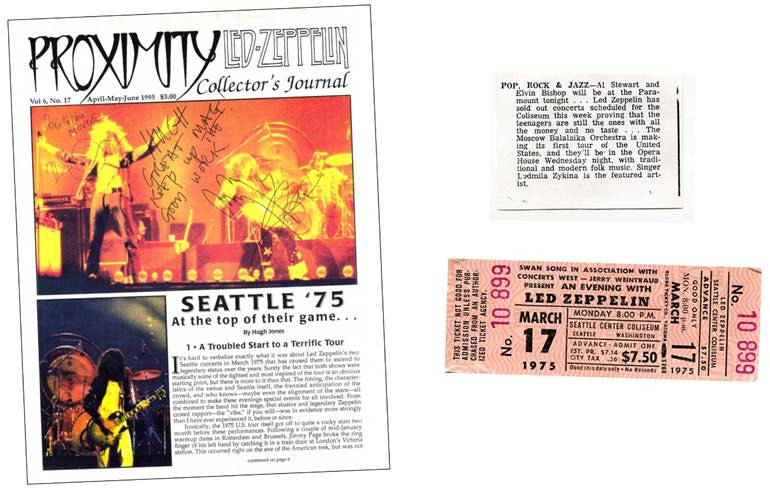
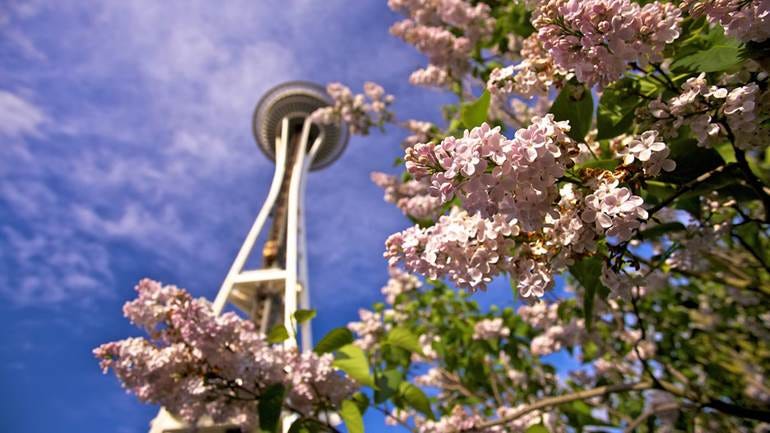
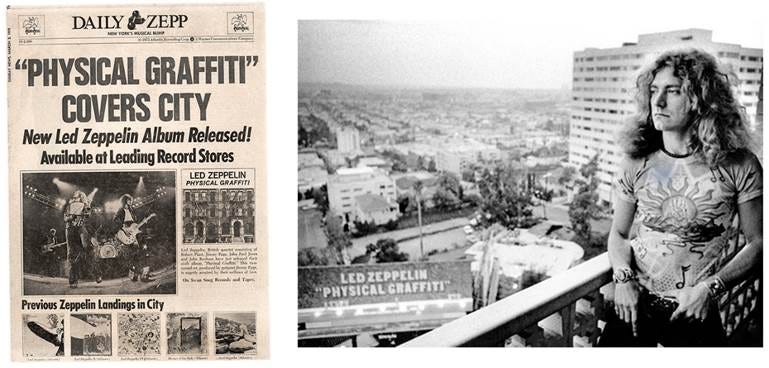


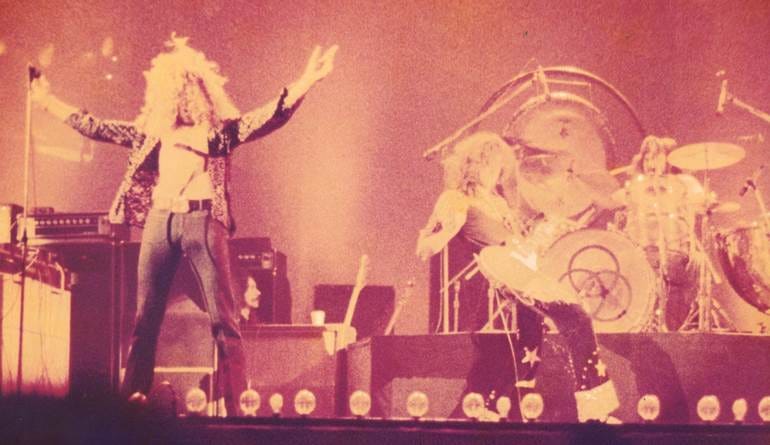
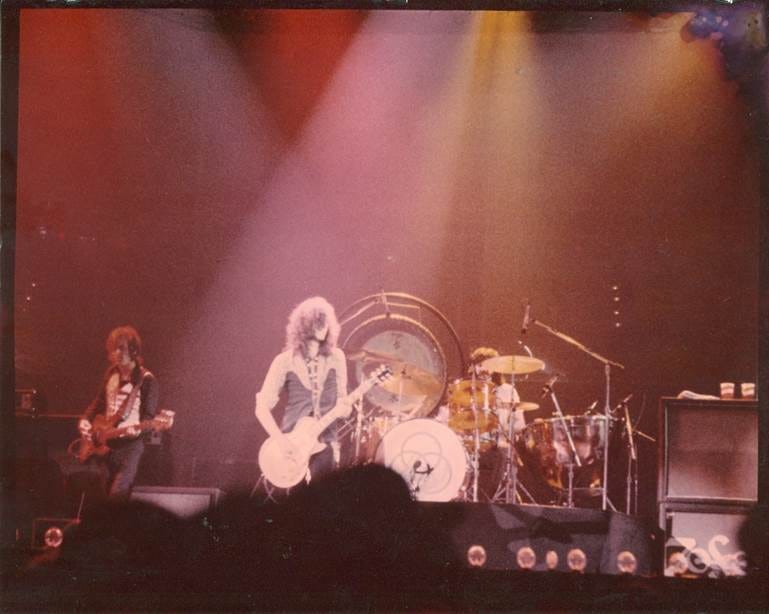

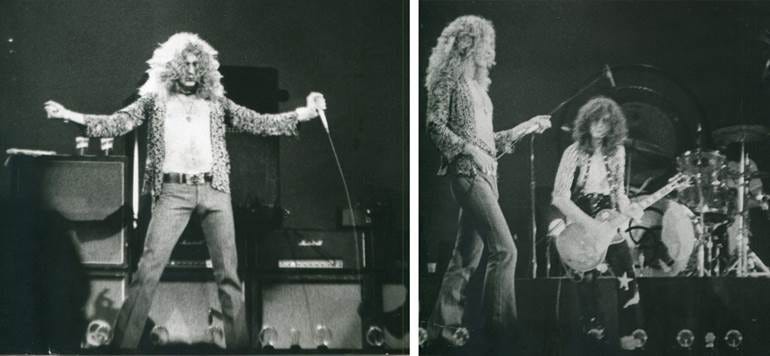

Good one, Hugh. I was in 8th grade at the time of that tour. A skinny little red head with a copy of Led Zeppelin IV, Houses of the Holy, and on my way to purchase Physical Graffiti. By high school I had my first bootleg cassettes of the band and a dual TEAC tape deck, dubbing tapes like a madman. One of my favorites from the Boston Tea Party in 1969 got an upgrade a few years back. I'm sure you sampled that one. If not, dig in: https://youtu.be/obyeYbXiMrA?si=6TLjUmxq2VwnUqGZ
"...high and fast. The only way to fly."
Thanks Hugh, I saw the 1975 Mpls. show and it was a disaster ! one of the worst shows I saw back in the 70's. Jimmy's broken finger and could barely play and Roberts Voice sounded terrible. unfortunately, that show turned me off to the Band forever. never gave them another chance ? probably my Bad ? Thanks for the Story, Mike